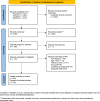Pelvic vs Lumbar Fusion in Neuromuscular Scoliosis - A Systematic Review
- PMID: 40173209
- PMCID: PMC11966631
- DOI: 10.1177/21925682251328620
Pelvic vs Lumbar Fusion in Neuromuscular Scoliosis - A Systematic Review
Abstract
Study DesignSystematic literature review.ObjectivesPosterior spinal fusion is the golden standard in the treatment of neuromuscular scoliosis. There are different views on whether pelvic fusion is necessary.MethodsA systematic literature review according to PRISMA guidelines was performed. A total of 628 articles were screened. Original articles of neuromuscular scoliosis patients with reference to posterior spinal fusion in the population of ≤20 years of age were included. Operative technique with lumbar pedicle screws was required. Case reports, articles with missing data on pelvic parameters or with a postoperative follow-up of less than 2 years were excluded. A final of 29 original articles were included in the review.ResultsA total of 1611 patients undergoing posterior spinal fusion for neuromuscular scoliosis were included in the analysis with a mean age of 14.0 ± 1.0 years and a mean number of 15.5 ± 0.8 levels fused. Spinal fusion was extended to the pelvis in 1222 cases, while in 389 patients had fusion limited to the lumbar spine. The percentage of main curve correction was slightly higher in pelvic fusion patients 63 ± 10% compared to 58 ± 9% in lumbar fusion group, P < 0.001. Pelvic obliquity correction was superior in the pelvic fusion group, 58% compared to 42% in the spinal fusion group, P < 0.001. Operative time, complication rate and perioperative bleeding were greater in the pelvic fusion group.ConclusionsPelvic fusion in posterior spinal fusion for neuromuscular scoliosis results in small but statistically significant differences in curve correction and pelvic obliquity but increases the risk for perioperative bleeding and other complications. The impact on quality of life should be addressed in future research.
Keywords: adolescent; neuromuscular scoliosis; pediatric; pelvic fusion; spinal fusion.
Conflict of interest statement
Declaration of Conflicting InterestsThe author(s) declared no potential conflicts of interest with respect to the research, authorship, and/or publication of this article.
Figures
Similar articles
-
Growth-friendly Technique or Posterior Spinal Fusion With T-construct Pelvic Fixation in Nonambulatory Spinal Muscular Atrophy With Severe Scoliosis.J Pediatr Orthop. 2025 Oct 1;45(9):525-530. doi: 10.1097/BPO.0000000000003008. Epub 2025 May 20. J Pediatr Orthop. 2025. PMID: 40391594
-
What Are the Medium-term Reciprocal Changes in Cervical Sagittal Alignment After Posterior Correction for Lenke 5C Adolescent Idiopathic Scoliosis?Clin Orthop Relat Res. 2025 Mar 21;483(9):1746-1758. doi: 10.1097/CORR.0000000000003448. Clin Orthop Relat Res. 2025. PMID: 40117516
-
Patient and surgical predictors of 3D correction in posterior spinal fusion: a systematic review.Eur Spine J. 2023 Jun;32(6):1927-1946. doi: 10.1007/s00586-023-07708-2. Epub 2023 Apr 20. Eur Spine J. 2023. PMID: 37079078
-
Use of a Hybrid Technique in the Surgical Correction of Severe Neuromuscular Scoliosis (Curves ≥85 Degrees): A Retrospective Study and Review of the Literature.Cureus. 2025 Jun 21;17(6):e86497. doi: 10.7759/cureus.86497. eCollection 2025 Jun. Cureus. 2025. PMID: 40693087 Free PMC article.
-
Intraoperative image guidance compared with free-hand methods in adolescent idiopathic scoliosis posterior spinal surgery: a systematic review on screw-related complications and breach rates.Spine J. 2017 Sep;17(9):1215-1229. doi: 10.1016/j.spinee.2017.04.001. Epub 2017 Apr 17. Spine J. 2017. PMID: 28428081
References
-
- Roberts SB, Tsirikos AI. Factors influencing the evaluation and management of neuromuscular scoliosis: a review of the literature. J Back Musculoskelet Rehabil. 2016;29(4):613-623. - PubMed
-
- Pruijs JE, van Tol MJ, van Kesteren RG, van Nieuwenhuizen O. Neuromuscular scoliosis: clinical evaluation pre- and postoperative. J Pediatr Orthop B. 2000;9(4):217-220. - PubMed
-
- Lonstein JE, Akbarnia A. Operative treatment of spinal deformities in patients with cerebral palsy or mental retardation. An analysis of one hundred and seven cases. J Bone Joint Surg Am. 1983;65(1):43-55. - PubMed
Publication types
LinkOut - more resources
Full Text Sources


